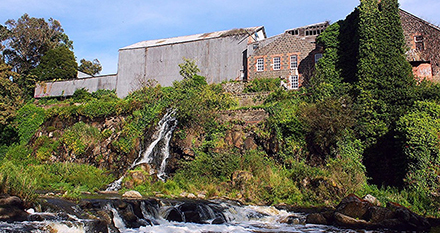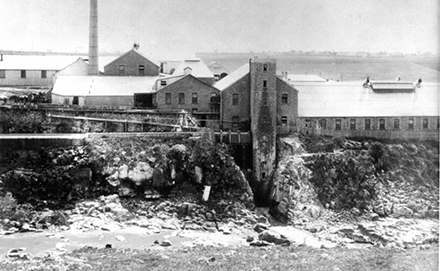Though it has not been in operation for many years, Australia’s oldest paper mill is still standing on the banks of the Barwon River at Fyansford, just outside Geelong in Victoria. Constructed from 1876-78, the mill’s bluestone and brick buildings are still in place, as are the manager’s house, six workers’ cottages and the stone weir and water race used to provide energy to the Barwon Paper Mills. Sources: IndustryEdge, Timberbiz
It is the last – the stone weir and the mill water race –that is the most striking remainder of the mill and its history. Although falling into disrepair now, the weir diverts water toward the mill race, which then runs close to one kilometre before reaching a pool where it once turned an impeller, before spilling over a slipway, back to the river.
It is overgrown now, but the millrace and the slipway just to the left of the tower can still be observed through the foliage.
The mill reportedly commenced operating in 1878, and was relatively short-lived as a paper mill, closing in1923.
The paper machine’s deckle was an impressive 198-200 cm, capable of being extended to 210 cm. The mill ran on rags and other cloth, collected from around the region. It produced bag grade paper for use in local industrial processes.
Ultimately, what is most significant in many respects is that this mill only ever ran on recycled materials like offcuts of rope, recycled books, sails, straw and other by products.
Work at the Barwon Paper Mills was not always pleasant, with one job involving cutting buttons off old clothes. Locals regularly find discarded buttons on a hill– funnily enough known now as ‘Button Hill’ – above the mill complex.
The dirtiest work was reserved for women, who made up about half the workforce.
In 1888, the Barwon Paper Mill was acquired by the Victorian Paper Manufacturing Company.
In 1895, the Australian Paper Mills company (APM) acquired the other company and its sites, including the mill at Fyansford. APM went on to become Amcor, and from a papermaking perspective, the remaining tendrils of that company’s industrial DNA is contained inside Opal Australia.
After papermaking ceased, from 1929 to 1941, the site was home to the Hydro Ice Company which used the premises as cool stores and to manufacture ice. Since that time, the facility has been home to a variety of small manufacturing and craft related activities, many at the same time.
The National Trust listed building is now privately owned.
Photos courtesy of Fyansford and more information is at www.fyansford.com









